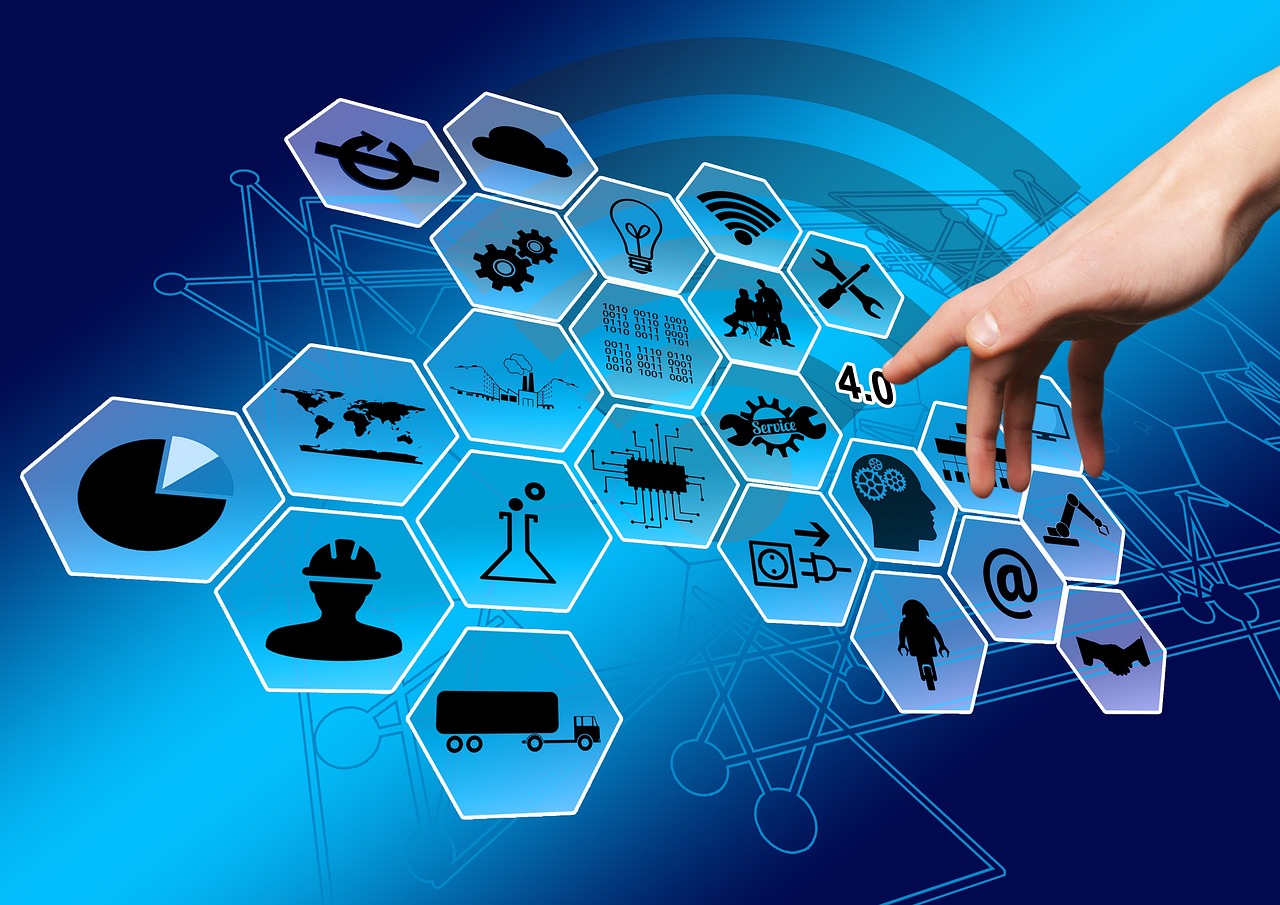How Blockchain Technology is Enhancing User Experience in Apps
In recent years, blockchain technology has emerged as a game-changer in the digital landscape, especially when it comes to enhancing user experience in applications. Imagine a world where your personal data is secure, transactions are transparent, and processes are automated seamlessly—this is the promise that blockchain brings to the table. By leveraging its decentralized nature, applications are not only becoming more efficient but also more trustworthy. This article dives deep into how blockchain is revolutionizing the way users interact with apps across various sectors, highlighting its benefits, challenges, and the potential it holds for the future.
Before we dive into the specifics, it's essential to grasp what blockchain technology really is. At its core, blockchain is a decentralized ledger system that records transactions across multiple computers. This means that no single entity owns the data, and every participant in the network has access to the same information. The structure of blockchain consists of blocks that contain data, and these blocks are linked together in a chronological order, creating a chain. Each transaction is encrypted and time-stamped, ensuring that the data is secure and tamper-proof. This foundational understanding sets the stage for appreciating how blockchain enhances user experience in applications.
One of the standout features of blockchain technology is its robust security. Traditional applications often rely on centralized databases, making them vulnerable to data breaches and unauthorized access. In contrast, blockchain employs advanced encryption techniques and decentralized data storage, significantly reducing these risks. Users can feel confident knowing that their sensitive information is safeguarded. Moreover, the decentralized nature of blockchain minimizes single points of failure, thereby making applications more resilient against attacks. This not only boosts user trust but also enhances the overall experience.
Decentralization is a key principle of blockchain technology, and it brings several benefits to users. By distributing data across multiple nodes, it eliminates the risk of a single point of failure. This means that even if one node goes down, the application continues to function seamlessly. Think of it like a well-organized team; if one member is absent, the rest can still carry on without a hitch. This resilience fosters a sense of security and reliability among users, which is crucial for any application aiming to provide a superior user experience.
Another significant advantage of blockchain is its ability to ensure data integrity. Once a transaction is recorded on the blockchain, it becomes immutable, meaning it cannot be altered or deleted. This feature is particularly important for users who need to trust that the information they are accessing is accurate and reliable. For instance, in financial applications, users can verify their transaction history without fear of discrepancies or fraud. This level of transparency and assurance enhances user confidence, making them more likely to engage with the application.
In today's digital age, users are increasingly concerned about their privacy. Blockchain technology addresses this concern by allowing users to have greater control over their personal data. With traditional apps, users often surrender their information without knowing how it will be used. However, blockchain empowers users to manage their data more effectively, providing options to share only what is necessary. This enhanced privacy control not only satisfies user demands but also builds a stronger relationship between users and service providers.
Smart contracts are another innovative feature of blockchain technology that significantly enhances user experience. These are self-executing contracts with the terms of the agreement directly written into code. They automate processes within applications, enabling trustless transactions that eliminate the need for intermediaries. Imagine ordering a ride; with smart contracts, payment is automatically processed once the ride is completed, reducing delays and errors. This efficiency not only streamlines operations but also leads to a smoother and more enjoyable user experience.
Transparency is a fundamental aspect of blockchain technology that fosters trust between users and service providers. With blockchain, users can verify the authenticity of transactions in real-time, which is a significant shift from traditional systems where users often have to rely on third-party confirmations. This level of transparency empowers users, making them feel more in control of their interactions. For example, in e-commerce, customers can track their orders at every stage, from shipment to delivery, ensuring that they are always informed.
Blockchain's transparent nature also enables real-time auditing capabilities. Users can easily track their transactions and verify their legitimacy without having to depend on external authorities. This not only saves time but also enhances user confidence in the application. Whether it's checking a payment status or verifying the authenticity of a product, blockchain provides users with the tools they need to make informed decisions.
The impact of blockchain on user experience is not limited to a single industry. It spans across various sectors, including:
- Finance: Secure transactions and reduced fraud.
- Healthcare: Improved patient data management and privacy.
- Supply Chain Management: Enhanced traceability and accountability.
Each of these industries is leveraging blockchain technology to create innovative applications that not only meet user needs but also exceed their expectations.
Despite its numerous advantages, blockchain technology is not without challenges. Issues such as scalability and energy consumption must be addressed to fully realize its potential in enhancing user experience.
Scalability remains a significant hurdle for blockchain applications. As the number of users increases, transaction speeds can slow down, leading to higher costs and affecting overall user satisfaction. It's like trying to fit a growing crowd into a small room; eventually, it becomes uncomfortable. Developers are actively working on solutions to improve scalability, ensuring that user experience remains a top priority.
The energy-intensive nature of some blockchain networks raises concerns about sustainability. As more applications adopt blockchain technology, the demand for energy can skyrocket, prompting the need for more eco-friendly alternatives. Striking a balance between performance and environmental impact is crucial for enhancing user experience without compromising our planet's health.
Q: What is blockchain technology?
A: Blockchain is a decentralized ledger system that records transactions securely across multiple computers.
Q: How does blockchain enhance user experience?
A: It improves security, ensures data integrity, offers enhanced privacy controls, and automates processes through smart contracts.
Q: What industries are benefiting from blockchain?
A: Industries such as finance, healthcare, and supply chain management are leveraging blockchain to enhance user experience.
Q: What challenges does blockchain face?
A: Scalability and energy consumption are two significant challenges that need to be addressed for broader adoption.

Understanding Blockchain Technology
This article explores the transformative impact of blockchain technology on user experience in applications, highlighting its benefits, challenges, and future potential in various sectors.
Blockchain technology is often described as a digital ledger system, but it’s much more than that. At its core, it operates on the principle of decentralization, meaning that no single entity has control over the entire network. Imagine a public library where everyone has the ability to add books, but no one can remove them. This is similar to how blockchain records transactions. Each transaction is stored in a block, and once that block is filled, it is linked to the previous block, creating a chain of blocks—hence the name "blockchain".
The beauty of this system lies in its transparency and security. Each participant in the blockchain network has access to the entire ledger, which means that any changes or additions are visible to everyone. This transparency helps in building trust among users, as they can independently verify transactions without relying on a central authority. Moreover, the cryptographic techniques used in blockchain ensure that data is not only secure but also resistant to tampering. Think of it as a digital vault where your information is locked away, and only you have the key.
To further understand how blockchain operates, let’s break down its key components:
- Blocks: Each block contains a list of transactions, a timestamp, and a reference to the previous block.
- Nodes: These are the computers that participate in the network, maintaining a copy of the blockchain.
- Consensus Mechanisms: These are protocols that ensure all nodes agree on the validity of transactions before they are added to the blockchain.
This decentralized approach not only enhances security but also increases the overall efficiency of applications. Traditional systems often rely on intermediaries to facilitate transactions, which can slow things down and introduce potential points of failure. With blockchain, users can engage directly with each other, eliminating the need for middlemen and expediting processes.
In summary, blockchain technology is a revolutionary approach to data management that provides a secure, transparent, and efficient means of handling transactions. As we dive deeper into its applications, we will see how these foundational principles translate into real-world benefits for users in various sectors.
Blockchain technology enhances app security by providing robust encryption and decentralized data storage, reducing the risk of data breaches and unauthorized access.
Decentralization minimizes single points of failure, making apps more resilient and secure against attacks, thus improving overall user trust and experience.
Blockchain ensures data integrity by recording transactions in an immutable manner, meaning once data is added, it cannot be altered or deleted, enhancing user confidence.
Users benefit from improved privacy controls, as blockchain allows for better management of personal data, giving users more control over their information.
Smart contracts automate processes within apps, enabling trustless transactions that streamline operations and enhance user experience by reducing delays and errors.
Transparency in transactions fosters trust between users and service providers, as blockchain allows users to verify the authenticity of transactions in real-time.
Blockchain's transparent nature enables real-time auditing, allowing users to track their transactions and verify their legitimacy without relying on third parties.
This section highlights specific industries where blockchain is enhancing user experience, showcasing innovative applications in finance, healthcare, and supply chain management.
Despite its advantages, blockchain technology faces challenges such as scalability issues and energy consumption, which must be addressed to fully realize its potential in user experience enhancement.
Scalability remains a significant hurdle for blockchain applications, as increased usage can lead to slower transaction speeds and higher costs, affecting user satisfaction.
The energy-intensive nature of some blockchain networks raises concerns about sustainability, prompting the need for more eco-friendly alternatives to enhance user experience without environmental compromise.
Q: What is blockchain technology?
A: Blockchain technology is a decentralized digital ledger that records transactions across many computers securely and transparently.
Q: How does blockchain enhance security?
A: By using cryptographic techniques and decentralization, blockchain reduces the risk of data breaches and unauthorized access.
Q: What are smart contracts?
A: Smart contracts are self-executing contracts with the terms directly written into code, allowing for automated and trustless transactions.
Q: What industries can benefit from blockchain?
A: Industries such as finance, healthcare, and supply chain management are actively exploring blockchain to enhance user experience and operational efficiency.

Improved Security Features
In today's digital landscape, where data breaches and cyber threats are rampant, the importance of security in applications cannot be overstated. This is where blockchain technology steps in as a game changer, providing a robust framework that enhances the security features of applications. By leveraging its unique characteristics, blockchain offers a level of protection that traditional systems struggle to match. Imagine a fortress built on a decentralized network, where each brick is a transaction that cannot be altered or removed without consensus. This is the essence of blockchain, creating a secure environment for users and their sensitive information.
One of the key security benefits of blockchain technology lies in its decentralized data storage. Unlike conventional systems that rely on a central server, blockchain distributes data across a network of nodes. This means that even if one node is compromised, the integrity of the entire system remains intact. This reduces the risk of data breaches and unauthorized access, making it significantly harder for malicious actors to exploit vulnerabilities. With every transaction being encrypted and stored in a tamper-proof manner, users can rest assured that their data is safe from prying eyes.
Decentralization is not just a buzzword; it’s a fundamental principle that enhances security in applications. By eliminating single points of failure, blockchain makes apps more resilient against attacks. Think of it like a spider web—if one strand breaks, the web still holds together. This increased resilience fosters a greater sense of trust among users. When people feel secure, their overall experience improves dramatically. They are more likely to engage with the app, share their information, and utilize its features without fear of compromise.
Another significant aspect of blockchain technology is its ability to ensure data integrity. Once a transaction is added to the blockchain, it becomes immutable—meaning it cannot be altered or deleted. This characteristic is crucial for users who demand transparency and reliability from the applications they use. For instance, in financial services, users can track their transactions in real-time, knowing that the data they see is accurate and trustworthy. This assurance not only enhances user confidence but also elevates the overall user experience.
In a world where data privacy is a growing concern, blockchain technology offers enhanced privacy controls that empower users. With blockchain, individuals have more control over their personal information. They can decide what data to share and with whom, minimizing the risk of data misuse. This is akin to having a personal vault where you can store your valuables—only you hold the key. By giving users the ability to manage their data, blockchain fosters a sense of security that enhances user satisfaction and encourages continued engagement with the application.
In conclusion, the provided by blockchain technology are revolutionizing the way users interact with applications. With its decentralized structure, data integrity assurance, and enhanced privacy controls, blockchain not only mitigates risks but also builds trust. As more applications adopt this technology, we can expect to see a significant shift in user experience, characterized by a newfound confidence in the security of their data.

Decentralization and Its Benefits
Decentralization is one of the most powerful aspects of blockchain technology, fundamentally reshaping how we think about data management and application security. Imagine a world where no single entity holds the keys to your information—sounds like a dream, right? Well, that dream is becoming a reality thanks to decentralized systems. In a decentralized setup, data is distributed across a network of computers rather than being stored in a single, vulnerable location. This means that there are no single points of failure, making it significantly harder for malicious actors to compromise the system.
When applications leverage decentralization, they become more resilient and secure against attacks. For instance, if one node in the network goes down or is attacked, the rest can continue to function normally. This not only boosts the reliability of the application but also enhances the overall user trust. Users can feel confident that their data is safe, knowing that it isn’t just sitting in a centralized database waiting to be hacked. Think of it like a well-guarded treasure—if one guard is taken out, there are still many others to protect the loot.
Moreover, decentralization allows users to have more control over their own data. In traditional centralized systems, users often have to surrender their data to companies that may not have their best interests at heart. With blockchain, users can manage their personal information directly, deciding who gets access and under what conditions. This empowerment leads to a more engaging user experience, as individuals feel they are the true owners of their data rather than just passive participants in a system that exploits them.
To illustrate the benefits of decentralization, consider the following points:
- Enhanced Security: With data spread across multiple nodes, the risk of a data breach is significantly reduced.
- Increased Trust: Users are more likely to trust applications that do not rely on a single entity to manage their data.
- Greater Control: Decentralization empowers users to take charge of their information, leading to a more personalized experience.
In summary, decentralization is not just a technical feature; it’s a game changer that enhances user experience by providing security, trust, and control. As we continue to explore the vast potential of blockchain technology, understanding these benefits will be crucial for developers and users alike, paving the way for a more secure and user-centric digital future.
Q1: What is decentralization in blockchain?
A1: Decentralization in blockchain refers to the distribution of data across a network of computers rather than storing it in a single location. This enhances security and reduces the risk of data breaches.
Q2: How does decentralization improve user trust?
A2: By eliminating single points of failure and allowing users to control their own data, decentralization fosters a sense of security and trust between users and applications.
Q3: Can decentralization lead to faster transactions?
A3: While decentralization enhances security and trust, it can sometimes lead to slower transaction speeds due to the need for consensus across the network. However, ongoing advancements are addressing these challenges.
Q4: What are the main benefits of decentralization?
A4: The main benefits include enhanced security, increased user trust, and greater control over personal data, all of which contribute to an improved user experience.

Data Integrity Assurance
In today’s digital landscape, data integrity is paramount. With countless transactions and interactions occurring every second, the need for reliable and trustworthy data is more critical than ever. Blockchain technology steps in as a game-changer, providing a robust framework that ensures data integrity through its unique structure. Imagine a digital ledger that is not just a record but a fortress of information; once data is entered into the blockchain, it is immutable. This means that no one, not even the administrators, can alter or delete the data without consensus from the network.
This immutability is achieved through a consensus mechanism, where multiple nodes in the network validate transactions before they are added to the blockchain. Think of it as a group of friends who all need to agree on a story before it can be published. If one friend tries to change a detail, the others will quickly point it out, ensuring that the original story remains intact. This collective validation process not only secures the data but also enhances user confidence. Users can feel assured that their information is safe and that the records they are accessing are accurate and trustworthy.
Moreover, the decentralized nature of blockchain means that there is no single point of failure. If one node goes down or is compromised, the rest of the network continues to function seamlessly. This resilience is crucial for applications that require high data integrity, such as financial services and healthcare systems. For instance, if a hospital uses blockchain to store patient records, the integrity of those records is guaranteed, preventing unauthorized modifications that could jeopardize patient care. Additionally, the transparent nature of blockchain allows users to independently verify the authenticity of their data, further solidifying trust in the system.
In summary, blockchain technology not only enhances data integrity but also fosters a culture of trust between users and service providers. As we continue to embrace this technology in various applications, the promise of secure, reliable, and trustworthy data becomes a reality, paving the way for a more transparent digital future.
Frequently Asked Questions
- What is data integrity in blockchain? Data integrity in blockchain refers to the assurance that the data recorded on the blockchain is accurate, reliable, and cannot be altered or deleted without consensus from the network.
- How does blockchain ensure data integrity? Blockchain ensures data integrity through its immutable ledger, where transactions are verified by multiple nodes and cannot be changed once added.
- Why is data integrity important? Data integrity is crucial because it builds trust among users, ensures the accuracy of information, and prevents fraud or unauthorized changes to data.

Enhanced Privacy Controls
In today's digital age, where data breaches and privacy concerns are rampant, provided by blockchain technology are a breath of fresh air for users. Imagine having the power to manage your personal information just like a safe deposit box—only you hold the key. This is precisely what blockchain offers. Through its decentralized architecture, users can maintain greater control over their data, ensuring that it is only shared with parties they trust.
Blockchain's inherent design allows for the creation of cryptographic identities, which means that users can interact with applications without revealing their actual identities. This is akin to wearing a mask at a masquerade ball; you can engage freely while keeping your true self hidden. Such anonymity not only protects users from unwanted attention but also minimizes the risks associated with identity theft.
Furthermore, blockchain empowers users with the option to grant permissions for data access. Imagine you have a digital wallet that can be opened only with your consent; this is how blockchain operates. Users can specify who can see their data and for what purpose, thereby enhancing their privacy. For instance, in the healthcare sector, patients can share their medical records with doctors while keeping sensitive information hidden from insurance companies. This level of control is revolutionary.
Moreover, the use of zero-knowledge proofs in blockchain technology allows users to prove their identity or the validity of their data without revealing the actual data itself. This is like showing a ticket to enter a concert without disclosing your entire playlist. Such mechanisms provide a robust layer of privacy, ensuring that sensitive information remains confidential while still enabling necessary interactions.
In summary, blockchain technology not only enhances privacy controls but also builds a foundation of trust between users and service providers. With the ability to manage personal data proactively, users can navigate the digital landscape with confidence, knowing that their information is secure and under their control. This shift towards user-centric privacy is not just a trend; it is a fundamental change in how we perceive and handle our personal information in the digital world.

Smart Contracts in Applications
Imagine a world where agreements are executed automatically, without the need for intermediaries. This is the promise of smart contracts—a revolutionary application of blockchain technology that is transforming how we interact with digital services. Smart contracts are essentially self-executing contracts with the terms of the agreement directly written into code. They operate on blockchain networks, ensuring that once the conditions are met, the contract executes automatically, reducing the potential for human error and the need for trust in third parties.
One of the most significant benefits of smart contracts is their ability to streamline processes. For instance, in the real estate sector, smart contracts can automate the entire buying process. Once a buyer and seller agree on the terms, the smart contract can manage everything from the transfer of funds to the change of ownership, all without needing a notary or other intermediaries. This not only speeds up the transaction but also reduces costs associated with traditional processes.
Moreover, smart contracts enhance user experience by providing transparency and security. Since they are stored on the blockchain, all parties involved can view the contract and its execution in real-time. This transparency fosters trust, as users can verify that the contract is being executed as intended. Additionally, the immutable nature of blockchain means that once a smart contract is deployed, it cannot be altered or tampered with, ensuring that all parties adhere to the agreed terms.
Another exciting application of smart contracts is in the realm of decentralized finance (DeFi). Here, they facilitate everything from lending and borrowing to trading assets, all without the need for traditional financial institutions. Users can engage in trustless transactions, knowing that the smart contract will enforce the rules of the agreement without bias. This not only democratizes access to financial services but also empowers users by giving them more control over their financial activities.
However, it's essential to recognize that while smart contracts offer numerous advantages, they are not without challenges. For instance, the code must be meticulously written to avoid vulnerabilities that could be exploited. A small bug in the code can lead to significant financial losses. Therefore, rigorous testing and auditing of smart contracts are crucial before they are deployed.
In summary, smart contracts are revolutionizing the way applications operate by automating processes, enhancing security, and fostering transparency. As more industries begin to recognize the potential of this technology, we can expect to see a surge in innovative applications that further enhance user experiences. The future is bright for smart contracts, and their integration into various applications is just the beginning of a new era in digital transactions.
- What is a smart contract? A smart contract is a self-executing contract with the terms of the agreement directly written into code, operating on a blockchain.
- How do smart contracts enhance security? Smart contracts are secured by blockchain technology, making them immutable and tamper-proof, which enhances the overall security of transactions.
- Can smart contracts be used in any industry? Yes, smart contracts can be applied in various industries, including real estate, finance, healthcare, and supply chain management.
- What are the risks associated with smart contracts? The primary risks involve coding errors or vulnerabilities that could be exploited, necessitating thorough testing and auditing before deployment.

Transparent Transactions
In the digital age, where trust is often in short supply, transparency has become a key factor in fostering confidence between users and service providers. Blockchain technology revolutionizes this aspect by allowing users to verify the authenticity of transactions in real-time. Imagine a world where you could track every step of a transaction, seeing exactly where your money goes and how it’s used. This level of visibility not only enhances user experience but also builds a solid foundation of trust. Users can feel secure knowing that their transactions are recorded on a decentralized ledger, making them immutable and easily auditable.
One of the most significant advantages of transparent transactions is the ability to conduct business without the need for intermediaries. Traditional systems often rely on banks or other financial institutions to verify transactions, which can lead to delays and additional fees. With blockchain, users can engage in direct peer-to-peer transactions, cutting out the middleman and streamlining the entire process. This not only saves time but also reduces costs, making transactions more efficient and user-friendly.
Furthermore, the transparent nature of blockchain allows for real-time auditing capabilities. Users can track their transactions as they occur, enabling them to verify their legitimacy without needing to rely on third-party services. This is particularly beneficial in sectors like finance, where fraud and discrepancies can have severe consequences. By providing users with the tools to audit their transactions, blockchain empowers them to take control of their financial activities.
To illustrate the impact of transparent transactions, consider the following industries:
| Industry | Benefits of Transparency |
|---|---|
| Finance | Real-time tracking reduces fraud and increases trust. |
| Healthcare | Patients can verify the authenticity of their medical records. |
| Supply Chain | Consumers can trace the origin of products, ensuring quality and ethical sourcing. |
In conclusion, the transparency offered by blockchain technology is not just a buzzword; it’s a transformative feature that enhances user experience across various applications. By enabling users to verify transactions in real-time and eliminating the need for intermediaries, blockchain fosters a new era of trust and efficiency. As we continue to embrace this technology, we can expect to see even more innovative applications that prioritize user experience and transparency.
- What is blockchain technology? Blockchain technology is a decentralized ledger system that records transactions across many computers so that the recorded transactions cannot be altered retroactively.
- How does blockchain enhance security? Blockchain enhances security through robust encryption and decentralization, reducing the risk of data breaches and unauthorized access.
- What are smart contracts? Smart contracts are self-executing contracts with the terms of the agreement directly written into code, allowing for automated processes within applications.
- What industries benefit most from blockchain transparency? Industries such as finance, healthcare, and supply chain management benefit significantly from the transparency that blockchain technology provides.

Real-Time Auditing Capabilities
In today's fast-paced digital world, the ability to conduct real-time audits is becoming increasingly crucial for both users and organizations. Thanks to blockchain technology, the auditing process has transformed from a tedious, often delayed task into a swift, transparent operation. Imagine being able to verify your transactions as they happen, without having to wait for cumbersome monthly reports or third-party confirmations. This is the power of blockchain.
At its core, blockchain operates as a decentralized ledger that records all transactions in a transparent manner. This means that each participant in the network has access to the same information, fostering a sense of trust and accountability. When a transaction occurs, it is instantly recorded on the blockchain, and all network participants can see it in real-time. This eliminates the need for intermediaries, which often slow down the auditing process and introduce potential for errors or fraud.
One of the standout features of blockchain's auditing capabilities is its immutability. Once a transaction is recorded, it cannot be altered or deleted. This characteristic ensures that the data remains intact and trustworthy. Users can easily track their transactions and verify their legitimacy without relying on third parties, which is a game-changer for industries like finance and supply chain management where transparency is paramount.
To illustrate the impact of real-time auditing, consider the following table that compares traditional auditing methods with blockchain-enabled auditing:
| Feature | Traditional Auditing | Blockchain Auditing |
|---|---|---|
| Transaction Verification Time | Days to Weeks | Instant |
| Data Integrity | Vulnerable to Tampering | Immutable |
| Audit Trail Accessibility | Limited Access | Open to All Participants |
| Cost of Auditing | High | Lower Due to Automation |
This table clearly shows how blockchain technology enhances the auditing process. By providing instant transaction verification, immutable records, and lower costs, blockchain not only improves efficiency but also builds a stronger foundation of trust between users and service providers.
Moreover, the real-time auditing capabilities of blockchain technology can significantly reduce the risk of fraud. Since every transaction is recorded and can be traced back, any discrepancies can be quickly identified and addressed. This proactive approach to auditing means users can have peace of mind knowing their transactions are secure and transparent.
In conclusion, the ability to perform real-time audits via blockchain technology is revolutionizing how we approach transparency and trust in transactions. As more industries adopt this technology, we can expect to see enhanced user experiences, reduced fraud, and a shift towards more accountable business practices.
- What is real-time auditing? Real-time auditing refers to the ability to verify and track transactions instantly as they occur, ensuring transparency and accuracy.
- How does blockchain ensure data integrity? Blockchain maintains data integrity by recording transactions in an immutable manner, meaning once data is added, it cannot be altered or deleted.
- What industries benefit from real-time auditing? Industries such as finance, healthcare, and supply chain management greatly benefit from real-time auditing capabilities offered by blockchain technology.
- Can real-time auditing reduce fraud? Yes, real-time auditing can significantly reduce fraud by providing a transparent and traceable record of transactions.

Use Cases in Various Industries
Blockchain technology is revolutionizing various industries by enhancing user experience through innovative applications. One of the most notable sectors is finance. In this industry, blockchain enables faster and more secure transactions, reducing the need for intermediaries such as banks. This not only streamlines the transaction process but also significantly lowers transaction fees, making it more cost-effective for users. Imagine sending money across borders in seconds, with minimal fees and complete transparency—this is the power of blockchain!
Another industry experiencing a blockchain boom is healthcare. Here, patient data security is paramount. Blockchain allows for the secure sharing of medical records among healthcare providers while ensuring that patients have control over their own data. This means that sensitive information is less vulnerable to breaches, and patients can trust that their health data remains confidential. Additionally, blockchain can improve the efficiency of drug supply chains, helping to track pharmaceuticals from production to delivery, thereby combating counterfeit drugs.
In the realm of supply chain management, blockchain offers unprecedented visibility and traceability. Companies can track products in real-time, ensuring that consumers receive authentic goods. For example, a customer can scan a QR code on a product to see its entire journey, from raw materials to the store shelf. This level of transparency not only enhances user trust but also promotes ethical sourcing and sustainability practices. The ability to verify the origin of products is becoming increasingly important to consumers who are mindful of their purchases.
Moreover, the real estate sector is beginning to adopt blockchain for property transactions. Traditional real estate deals can be cumbersome and time-consuming, often requiring extensive paperwork and intermediary involvement. With blockchain, property transactions can be executed as smart contracts, automating the process and reducing the need for third parties. This not only speeds up transactions but also minimizes the risk of fraud, creating a smoother experience for buyers and sellers alike.
Lastly, the gaming industry is leveraging blockchain to create decentralized gaming platforms where players can truly own their in-game assets. This means that items purchased in a game can be traded or sold outside the game environment, adding real-world value to virtual goods. Players can enjoy a more engaging experience, knowing that their investments in the game are secure and transferable.
To summarize, blockchain technology is not just a buzzword; it’s a transformative force across multiple industries. By enhancing security, transparency, and efficiency, blockchain is reshaping user experiences and setting new standards for trust and reliability.
- What is blockchain technology? Blockchain is a decentralized digital ledger that records transactions across many computers, ensuring that the recorded transactions cannot be altered retroactively.
- How does blockchain enhance user experience? By providing improved security, transparency, and efficiency, blockchain enhances user trust and satisfaction in various applications.
- What industries are benefiting from blockchain? Industries such as finance, healthcare, supply chain management, real estate, and gaming are seeing significant improvements due to blockchain technology.
- Are there challenges associated with blockchain? Yes, challenges like scalability and energy consumption need to be addressed to maximize blockchain's potential.

Challenges and Limitations
While blockchain technology offers remarkable advantages, it is not without its . These hurdles can impact the overall user experience, making it essential to address them for broader adoption. One of the most significant issues is scalability. As the number of users and transactions grows, many blockchain networks struggle to maintain speed and efficiency. This can lead to longer transaction times and increased fees, which can frustrate users who expect instant gratification in today's fast-paced digital world.
To illustrate this, let's take a look at a common scenario: imagine trying to send money to a friend using a blockchain-based app during a peak usage time. If the network is congested, you might find yourself waiting longer than expected for the transaction to be confirmed. This delay can diminish the user experience, leading to dissatisfaction and potentially driving users back to traditional payment methods.
Another pressing concern is the energy consumption associated with many blockchain networks, particularly those that use proof-of-work mechanisms. The environmental impact of these energy-intensive processes has sparked significant debate. For instance, some estimates suggest that Bitcoin mining alone consumes as much energy as entire countries. This raises questions about the sustainability of blockchain technology as more users flock to decentralized solutions.
Here's a quick comparison of energy consumption among various blockchain networks:
| Blockchain Network | Energy Consumption (TWh/year) |
|---|---|
| Bitcoin | 130 |
| Ethereum (Proof of Work) | 50 |
| Ethereum (Proof of Stake) | 0.01 |
| Cardano | 0.005 |
As shown in the table, transitioning to more energy-efficient consensus mechanisms, such as proof of stake, can significantly reduce the environmental footprint of blockchain technology. This shift not only addresses sustainability concerns but also enhances user experience by fostering a more responsible digital ecosystem.
Furthermore, the complexity of blockchain technology can be a barrier for many users. Understanding how to use decentralized applications (dApps) requires a certain level of technical knowledge that not everyone possesses. This steep learning curve can deter potential users who might otherwise benefit from the enhanced security and transparency that blockchain offers. Developers must strive to create more user-friendly interfaces and educational resources to bridge this gap.
In summary, while blockchain technology has the potential to revolutionize user experiences across various applications, it is crucial to address these challenges. By focusing on scalability, energy consumption, and user accessibility, we can pave the way for a more inclusive and efficient digital future. The journey is ongoing, but the potential rewards are immense.
- What is blockchain technology? Blockchain technology is a decentralized ledger system that records transactions across multiple computers securely and transparently.
- How does blockchain improve security? Blockchain enhances security through robust encryption and decentralized data storage, reducing the risk of data breaches.
- What are smart contracts? Smart contracts are self-executing contracts with the terms of the agreement directly written into code, automating processes and reducing errors.
- What challenges does blockchain face? Key challenges include scalability issues, high energy consumption, and user complexity.

Scalability Concerns
As promising as blockchain technology is, it isn't without its . Imagine trying to fill a bathtub with a garden hose: the water flows, but it takes forever to fill up. This analogy reflects the current state of many blockchain networks. While they are capable of processing transactions, the speed at which they can handle a surge in demand often leads to delays and increased costs. As more users flock to decentralized applications (dApps), the underlying infrastructure can become overwhelmed, akin to a traffic jam on a busy highway.
One of the primary culprits behind these scalability issues is the consensus mechanism used in many blockchain networks. For instance, the widely adopted Proof of Work (PoW) method, which underpins Bitcoin, requires significant computational power to validate transactions. This process not only slows down transaction speeds but also leads to higher energy consumption. In contrast, newer consensus mechanisms like Proof of Stake (PoS) are being explored to mitigate these concerns, but they come with their own set of challenges.
In a recent analysis, the following table summarizes the transaction speeds and costs associated with popular blockchain networks:
| Blockchain Network | Transaction Speed (TPS) | Average Transaction Cost |
|---|---|---|
| Bitcoin | 7 TPS | $2.00 |
| Ethereum | 30 TPS | $0.50 |
| Solana | 65,000 TPS | $0.00025 |
| Cardano | 250 TPS | $0.15 |
As seen in the table, while some newer blockchain networks like Solana boast impressive transaction speeds, traditional ones like Bitcoin and Ethereum struggle to keep up with the growing demand. This disparity can lead to user frustration, especially when they experience delays during peak times.
Moreover, scalability issues can have a ripple effect on user experience. When transaction speeds slow down, users may encounter longer waiting times, which can be particularly detrimental in sectors like finance and e-commerce where speed is crucial. Imagine trying to make a purchase during a flash sale, only to be met with a sluggish transaction process. It's enough to make anyone want to pull their hair out!
To tackle these scalability issues, developers are exploring various solutions, including:
- Layer 2 Solutions: These are secondary frameworks built on top of existing blockchains to improve transaction speeds without compromising security.
- Sharding: This involves splitting a blockchain into smaller, more manageable pieces, allowing for parallel processing of transactions, thus enhancing scalability.
- Hybrid Models: Combining public and private blockchains to optimize performance while maintaining decentralization.
In conclusion, while scalability concerns pose significant challenges for blockchain technology, ongoing innovations and solutions are paving the way for a more efficient future. Addressing these issues is essential not only for enhancing user experience but also for ensuring that blockchain technology can fulfill its promise across various industries.
- What is blockchain scalability? - Blockchain scalability refers to the ability of a blockchain network to handle a growing amount of work or its potential to accommodate growth.
- Why is scalability important for user experience? - Scalability affects transaction speeds and costs, which directly impact user satisfaction and trust in the application.
- What are some solutions to scalability issues? - Solutions include Layer 2 solutions, sharding, and hybrid models that combine different types of blockchains.

Energy Consumption Issues
One of the most pressing concerns surrounding blockchain technology is its energy consumption. As blockchain networks grow, particularly those that utilize a Proof of Work consensus mechanism, the energy required to maintain and secure these networks can skyrocket. This raises significant questions about sustainability and environmental impact. For instance, Bitcoin mining alone consumes as much energy as some small countries, leading to a growing debate on whether the benefits of blockchain outweigh its environmental costs.
To put this into perspective, consider the following comparison of energy consumption:
| Blockchain Network | Annual Energy Consumption (TWh) |
|---|---|
| Bitcoin | 97.7 |
| Ethereum | 44.94 |
| Visa | 0.5 |
This table illustrates that while traditional financial systems like Visa consume far less energy, the energy demands of blockchain networks, especially those reliant on mining, are substantial. The environmental impact of these energy requirements cannot be ignored, especially as climate change becomes an increasingly urgent issue.
In response to these challenges, many developers and organizations are exploring alternative consensus mechanisms, such as Proof of Stake (PoS) and other eco-friendly solutions. These alternatives aim to drastically reduce energy consumption while still maintaining the integrity and security of the blockchain. For example, PoS does not require the intensive computational power that Proof of Work does, thereby significantly lowering the energy footprint.
Moreover, some blockchain projects are actively investing in renewable energy sources to power their operations. This shift not only helps mitigate the environmental impact but also positions these projects as more sustainable options in the long run. As users become increasingly aware of these issues, they may gravitate toward platforms that prioritize sustainability, thus enhancing their overall experience.
Ultimately, addressing energy consumption in blockchain technology is not just about reducing costs or improving efficiency; it’s about ensuring that the technology can be adopted widely without compromising our planet's health. As the industry evolves, finding a balance between innovation and sustainability will be crucial for enhancing user experience while also being environmentally responsible.
- What is the main cause of high energy consumption in blockchain? The high energy consumption is primarily due to the mining process in Proof of Work systems, which requires significant computational power.
- Are there more sustainable alternatives to traditional blockchain? Yes, alternatives like Proof of Stake and other eco-friendly consensus mechanisms are being developed to reduce energy consumption.
- How can blockchain projects address their environmental impact? Many projects are investing in renewable energy sources and exploring less energy-intensive technologies to mitigate their impact.
Frequently Asked Questions
- What is blockchain technology?
Blockchain technology is a decentralized digital ledger that records transactions across many computers. This ensures that the recorded transactions cannot be altered retroactively, providing a high level of security and transparency.
- How does blockchain improve app security?
Blockchain enhances app security through robust encryption and decentralized data storage. This reduces the risk of data breaches and unauthorized access, making it much harder for cybercriminals to compromise user data.
- What are smart contracts and how do they work?
Smart contracts are self-executing contracts with the terms of the agreement directly written into code. They automate processes within applications, enabling trustless transactions that streamline operations and reduce delays and errors.
- Can blockchain technology ensure data integrity?
Yes, blockchain ensures data integrity by recording transactions in an immutable manner. Once data is added to the blockchain, it cannot be altered or deleted, which significantly enhances user confidence in the accuracy of the information.
- How does blockchain provide transparency in transactions?
Blockchain fosters transparency by allowing users to verify transactions in real-time. This means that users can track their transactions and verify their legitimacy without needing to rely on third parties, building trust between users and service providers.
- What are the main challenges facing blockchain technology?
Some of the main challenges include scalability issues, which can lead to slower transaction speeds and higher costs, and energy consumption concerns associated with certain blockchain networks, prompting the need for more sustainable solutions.
- How is blockchain being used in different industries?
Blockchain is being utilized in various industries such as finance for secure transactions, healthcare for maintaining patient records, and supply chain management for tracking goods. These applications enhance user experience by providing greater security and transparency.
- What are the benefits of decentralization in apps?
Decentralization minimizes single points of failure, making apps more resilient and secure against attacks. This not only improves overall user trust but also enhances the overall user experience by providing a more reliable service.



















